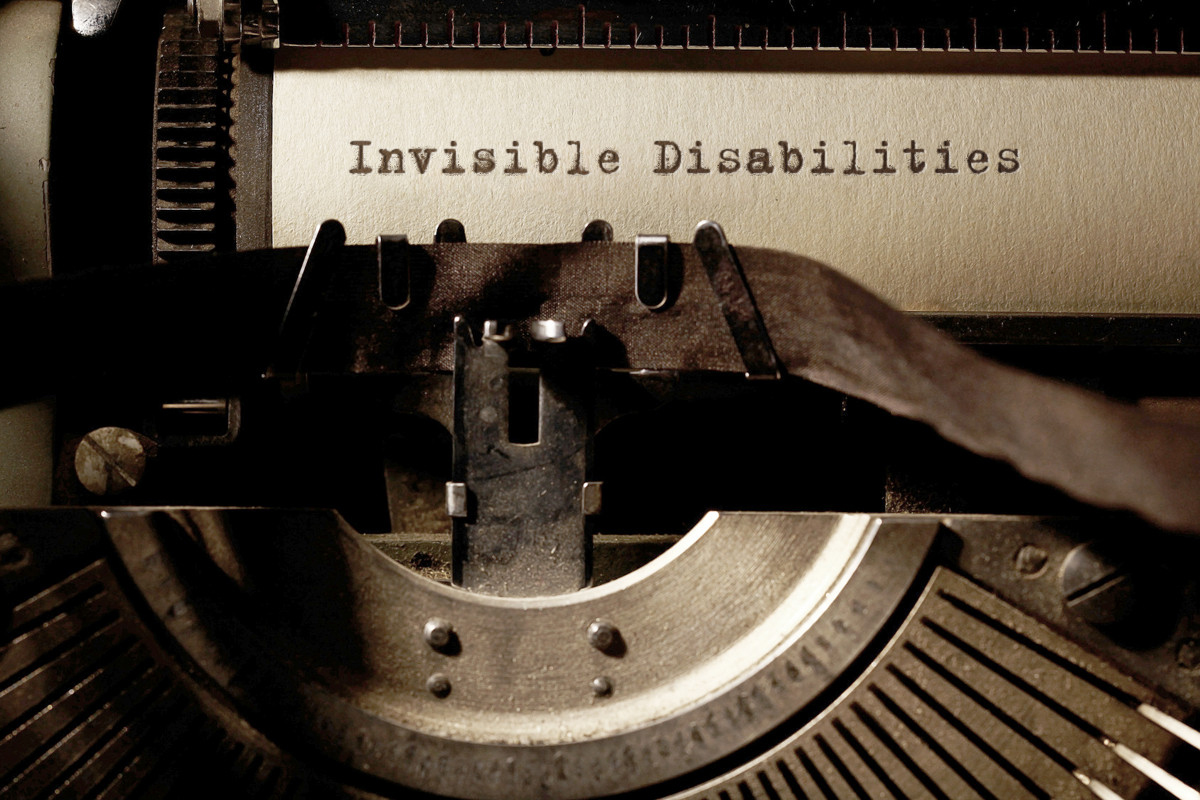
Unseen Struggles: Shedding Light on Invisible Disabilities and PIP Assessments
There are a lot of media discussions relating to invisible disabilities and illnesses, these conditions, while not immediately apparent to the casual observer, can significantly impact an individual’s daily life, often presenting unique challenges that are difficult to understand or quantify. In the United Kingdom, the Personal Independence Payment (PIP) assessment process plays a crucial role in determining eligibility for financial support. However, for those with invisible disabilities, navigating this system can be an uphill battle, with their conditions frequently misunderstood or underestimated.
The term “invisible disability” encompasses a broad spectrum of conditions, ranging from chronic pain, mental health disorders, and neurological conditions like autism or multiple sclerosis, to autoimmune diseases such as lupus or fibromyalgia. Despite the debilitating effects these conditions can have on individuals, their symptoms may not manifest visibly, leading to misconceptions and skepticism, particularly during PIP assessments.
One of the primary challenges faced by individuals with invisible disabilities during PIP assessments is the difficulty in providing tangible evidence of their conditions. Unlike visible disabilities, which may be readily apparent through physical indicators, such as mobility aids or visible scars, invisible disabilities often lack such overt markers. Consequently, individuals may struggle to convey the extent of their limitations and the impact on their daily functioning to assessors, leading to disparities in assessment outcomes.
Moreover, the subjective nature of many invisible disabilities poses additional hurdles in the assessment process. Mental health conditions, for instance, can fluctuate in severity, making it challenging to capture their full impact within the confines of a single assessment. Similarly, conditions like chronic pain or fatigue may vary in intensity from day to day, further complicating efforts to convey their consistent impact on one’s ability to engage in daily activities.
The proposed green paper on disability benefits and assessments offers an opportunity to address these issues and improve the support system for individuals with invisible disabilities. By recognizing the unique challenges faced by this demographic, policymakers can work towards implementing reforms that foster greater understanding and inclusivity within the PIP assessment framework.
Key recommendations for the green paper may include:
- Enhanced training for assessors: Equipping assessors with a deeper understanding of invisible disabilities and their diverse manifestations can help mitigate biases and ensure fairer assessments. This may involve providing education on the nuances of various conditions and strategies for evaluating their impact on individuals’ lives.
- Flexible assessment criteria: Recognizing the fluctuating nature of many invisible disabilities, the assessment criteria should be adaptable to accommodate variations in symptom severity over time. This could involve implementing periodic reviews or allowing individuals to provide evidence of their condition’s impact beyond a single assessment snapshot.
- Holistic assessment approach: Moving away from a solely medical model of assessment, there is a need to consider the broader social and environmental factors that contribute to individuals’ disability experiences. This could involve soliciting input from healthcare professionals, caregivers, and support networks to gain a comprehensive understanding of an individual’s needs and capabilities.
- Improved communication channels: Establishing clearer channels of communication between assessors and applicants can facilitate a more transparent and supportive assessment process. This may involve providing guidance on how individuals can effectively communicate their experiences and ensuring assessors are receptive to their input.
Unveiling the Spectrum: 30+ Invisible Disabilities and Conditions Challenging to Validate
- Fibromyalgia
- Chronic Fatigue Syndrome (CFS)
- Lupus (Systemic Lupus Erythematosus)
- Lyme Disease
- Rheumatoid Arthritis
- Ehlers-Danlos Syndrome (EDS)
- Complex Regional Pain Syndrome (CRPS)
- Irritable Bowel Syndrome (IBS)
- Crohn’s Disease
- Endometriosis
- Interstitial Cystitis
- Myalgic Encephalomyelitis (ME)
- Postural Orthostatic Tachycardia Syndrome (POTS)
- Multiple Chemical Sensitivity (MCS)
- Chronic Migraines
- Mast Cell Activation Syndrome (MCAS)
- Autoimmune Hepatitis
- Guillain-Barré Syndrome
- Sjögren’s Syndrome
- Psoriatic Arthritis
- Ankylosing Spondylitis
- Polycystic Ovary Syndrome (PCOS)
- Meniere’s Disease
- Hypothyroidism
- Hyperthyroidism
- Gastroparesis
- Complex PTSD
- Bipolar Disorder
- Borderline Personality Disorder (BPD)
- Schizophrenia
- Attention-Deficit/Hyperactivity Disorder (ADHD)
- Autism Spectrum Disorder (ASD)
- Generalized Anxiety Disorder (GAD)
- Obsessive-Compulsive Disorder (OCD)
- Post-Traumatic Stress Disorder (PTSD)
- Major Depressive Disorder (MDD)
This list represents only a fraction of the diverse range of invisible disabilities and conditions individuals may face. Each condition presents its own set of challenges, from debilitating symptoms to societal misconceptions, making them inherently difficult to prove or quantify in assessments like PIP.
Enhancing Credibility: Strategies for Claimants in PIP Assessments
Navigating the Personal Independence Payment (PIP) assessment process can be a daunting task, especially for individuals with invisible disabilities or conditions. The success of a PIP claim often hinges on the claimant’s ability to effectively communicate the impact of their disability on their daily life. While the system may present challenges, there are proactive steps claimants can take to strengthen the credibility of their claims and increase the likelihood of a favorable outcome.
- Gather Comprehensive Evidence: The foundation of a credible PIP claim lies in thorough documentation of one’s disability and its effects. This includes medical records history, specialist reports, prescription records, and any relevant test results. Additionally, maintaining a personal health journal can provide valuable insights into the fluctuating nature of certain conditions and help paint a more comprehensive picture for assessors.
- Provide Detailed Examples: When describing how your disability affects you, be specific and provide detailed examples of how it impacts various aspects of your daily life. Whether it’s difficulty with personal care tasks, mobility limitations, or challenges in engaging with social activities, concrete examples help assessors better understand the real-world impact of your disability.
- Seek Supportive Statements: Statements from healthcare professionals, caregivers, or support networks can offer additional credibility to your claim. These individuals can provide firsthand accounts of your condition and its effects, lending validation to your experiences.
- Prepare for the Assessment: Familiarize yourself with the PIP assessment process and what to expect during the evaluation. Take the time to review the criteria for eligibility and how your disability aligns with these criteria. Being prepared can help alleviate anxiety and ensure you effectively convey your needs during the assessment.
- Be Honest and Transparent: Integrity is key in establishing credibility. Be honest about your limitations and avoid exaggerating or downplaying the severity of your condition. Providing accurate information allows assessors to make informed decisions based on your genuine needs.
- Utilize Technology to Track Health: Leveraging digital tools can streamline the process of documenting your health and activities. Platforms like DisabledEntrepreneur.uk and DisabilityUK.co.uk offer spaces to track your health and daily activities, providing a convenient way to compile evidence to support your claim. These platforms allow you to record symptoms, medication usage, appointments, and other relevant information, facilitating a more comprehensive overview of your health journey.
- Seek Advocacy and Support: Don’t hesitate to seek guidance from advocacy organizations or support groups specializing in disability rights. These resources can provide valuable advice, assistance in understanding your rights, and support throughout the claims process.
- Appeal if Necessary: In the event of an unfavorable decision, consider appealing the outcome. Many successful claims are initially denied but approved upon appeal. Utilize the feedback provided, gather additional evidence if needed, and seek legal advice if necessary to navigate the appeals process effectively.
By taking proactive steps to enhance the credibility of your PIP claim, you can increase the likelihood of a successful outcome and access the support you need to manage your disability effectively. Remember, you are your own best advocate, and by effectively communicating your needs and experiences, you can ensure your voice is heard in the assessment process.
Conclusion
By addressing these issues and implementing reforms guided by the principles of empathy, fairness, and inclusivity, the proposed green paper has the potential to transform the PIP assessment process into a more equitable system for individuals with invisible disabilities. Through collaborative efforts between policymakers, healthcare professionals, advocacy groups, and affected individuals, we can strive towards a society where all disabilities, seen and unseen, are recognized, understood, and accommodated with dignity and respect.
We have compiled some useful resources which you can access here.
Andrew Jones is a seasoned journalist renowned for his expertise in current affairs, politics, economics and health reporting. With a career spanning over two decades, he has established himself as a trusted voice in the field, providing insightful analysis and thought-provoking commentary on some of the most pressing issues of our time.






